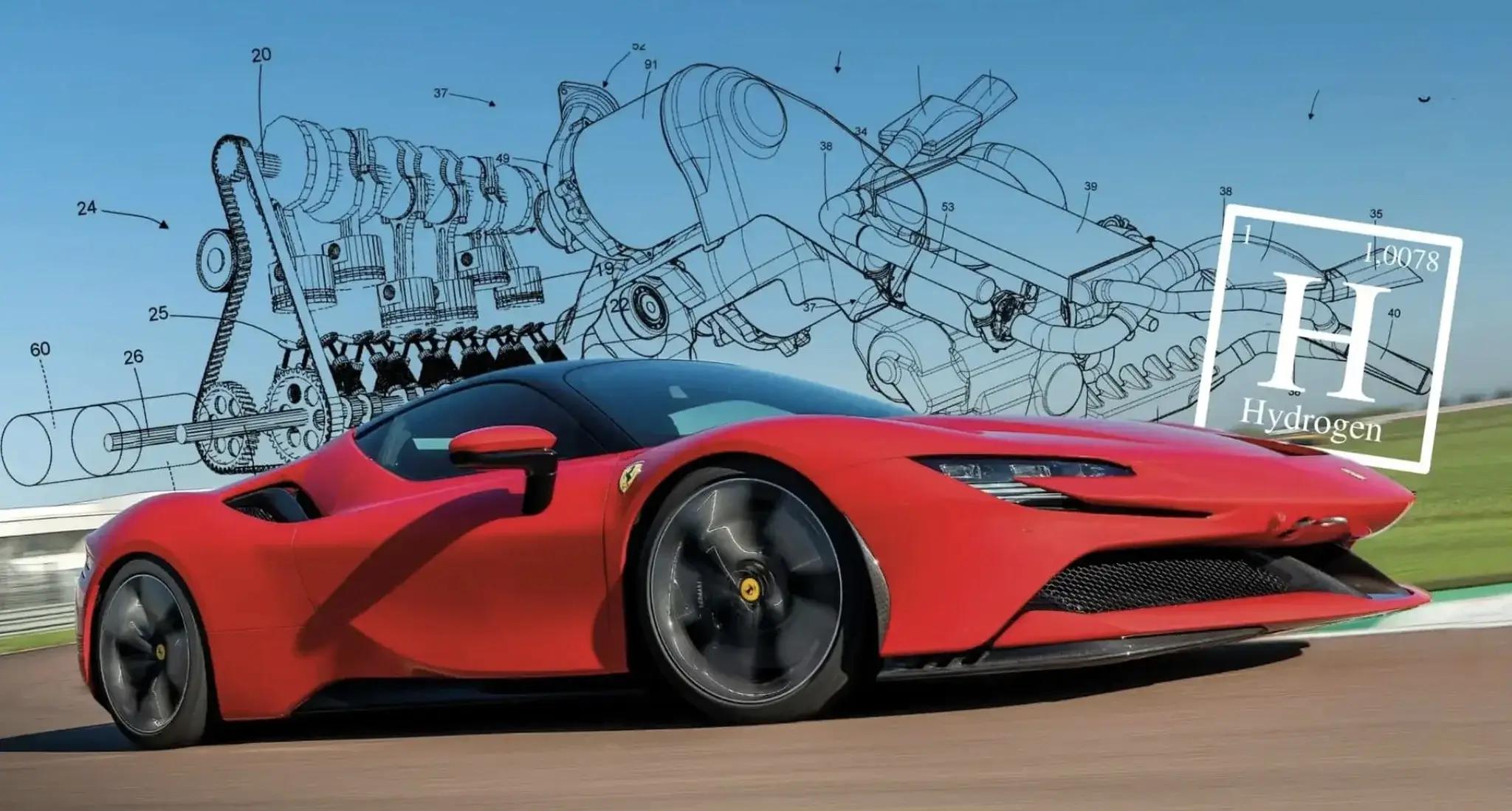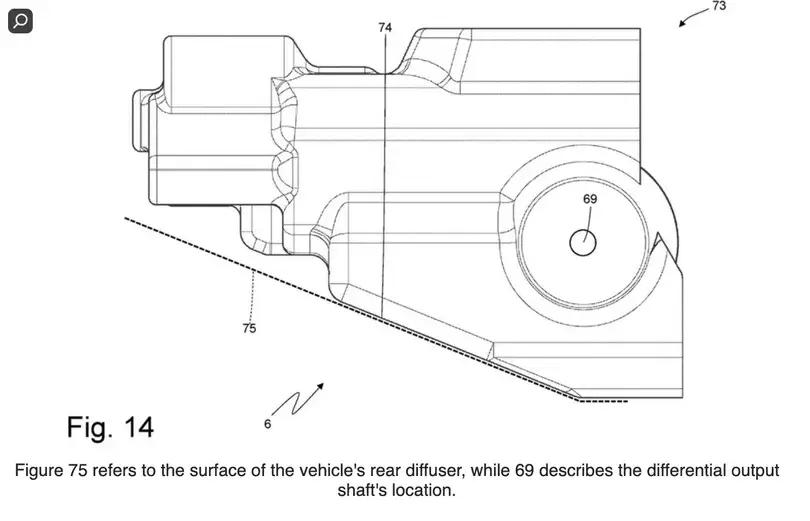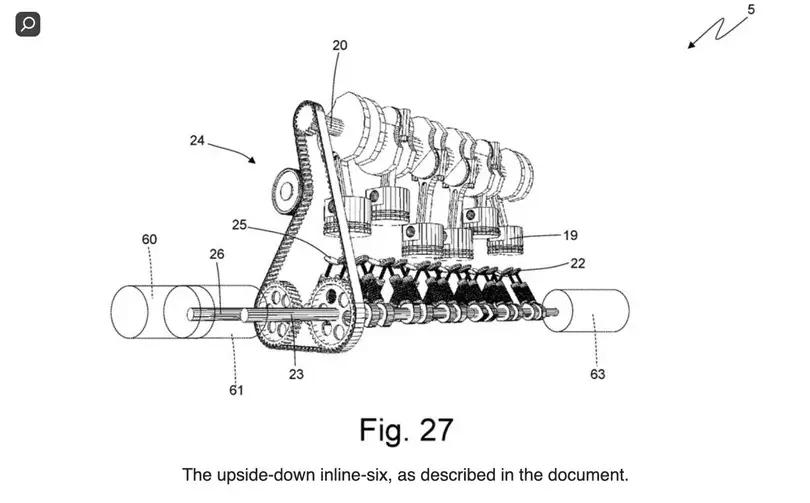Ferrari Wants to Build an Upside-Down, Hydrogen, Twin-Supercharged Inline-Six
Published By: NEWSROOM_REPOST

Automaker sometimes patent a single farfetched technology to protect an idea. But describing an unorthodox vehicle system with multiple unusual traits is far from the norm. That's what Ferrari did with this recent patent application, which is extreme, to say the least.
The document itself is titled "CAR PROVIDED WITH A HYDROGEN-POWERED INTERNAL COMBUSTION ENGINE," but it's actually only one of several documents that describe a number of unorthodox systems for a potential sports car. All of the patents are applications in the EU and US at the moment. They all share a single credited inventor: Fabrizio Favaretto. According to his LinkedIn, Favaretto has been employed by Ferrari for 24 years, currently holding the title of "Vehicle and Powertrain Architectures Innovation Manager."
The documents describe a hybrid sports car similar in basic configuration to the Corvette E-Ray. Engine at the back, electric motor up front. But that's where the similarities end. The actual electric traction system at the front axle is not described in great detail. At least, not in the documents I read. The rear-mounted engine and transaxle are the centerpiece.
The combustion engine is, in the primary embodiment, an inline-six fueled by hydrogen gas. It's an inline engine because that configuration provides room for hydrogen tanks on either side of it. The engine is also mounted upside down, i.e., the crankshaft is at the highest point of the engine while the cylinder head sits directly above the road.
The logic behind this is that the transaxle can now be placed higher up on the engine, which means a more aggressive diffuser can be installed at the back of the car. Some World War II fighter aircraft had upside-down engines like this, so it's not completely unheard of.
The same aggressive diffuser would be possible without this unusual arrangement, but the vehicle would be much longer—and the document insists a short wheelbase is very important.
It's all best described by this image:

The quirks don't end there. The engine features forced induction, that's for certain, but the patent describes several methods in which this forced induction may be achieved. In one embodiment, it consists of two centrifugal compressors mounted coaxially to either side of a single electric motor.
The energy to drive the compressors electrically would be generated under braking by the front drive unit, and although the word "battery" is not mentioned in the documents I read, it must be assumed that one would be used to store this energy.
Another embodiment puts the two compressors in a different arrangement but still drives them with an electric motor. Another describes an MGU-H type system with an exhaust gas turbine capable of recovering electrical energy to drive one or more compressors. The final iteration, as I understand it, ditches all manner of electric power, instead tapping power from one of the dual-clutch transmission's shafts to drive one or more mechanical superchargers directly. In this embodiment, there may be a transmission between the DCT and the supercharger to enable variable speeds. Multiple types of potential transmission are described. I'm not kidding.

One might worry about the potential serviceability of an upside-down engine, but the patent addresses those concerns. The oil and coolant pumps are all driven from the camshafts, for instance, which places them at the bottom of the engine in easy reach of technicians. A portion of the diffuser is also an engine cover, and it can be removed to access vital components.
Ferrari's system is, in short, a supercharged, hydrogen-combustion, inline-six, all-wheel-drive, hybrid sports car. Subject to change based on whatever the mad scientists at Maranello think works best.
Another publication, Autoguide, covered this patent in a skeptical, arguably negative manner. In its own words, the outlet described the technology as "unholy," and "sacrilege" for a brand such as Ferrari to consider. Entertainingly, Favaretto himself then appeared on Linkedin, where the article was shared by an associate of his, to defend the ideas.

"With the basic [physics] of hydrogen you must forget everything you know about how to design a car. Talk is cheap," he says in one comment. He then expands further on the ideas laid out in the patents, noting that Ferrari made an inline-six in the past based on the Lampredi V-12.
The whole thing is a very interesting episode. Skepticism is appropriate when discussing such radical ideas, naturally, but a smaller company like Ferrari with access to advanced in-house manufacturing techniques and very talented engineers has every ability to execute something like this.
The company already makes a six-cylinder hybrid car. If anything, going fully electric would be more sacrilegious. Innovating one's way out of a world where Ferraris—of all cars—fall silent is anything but.
By: Peter Holderith
PUBLISHED MAR 26, 2024 ON MOTOR1.COM










Comments (1)
The innovative patent from Ferrari, featuring an upside-down, hydrogen-powered engine with twin superchargers, is a clear indication of their forward-thinking and commitment to excellence. It's fascinating to see such radical ideas being pursued in the automotive world. For more information on their cutting-edge advancements, visit <a href="https://www.Ferrari.com">Ferrari</a>.